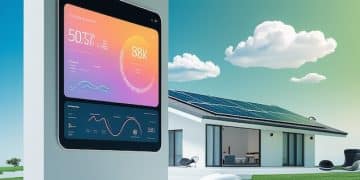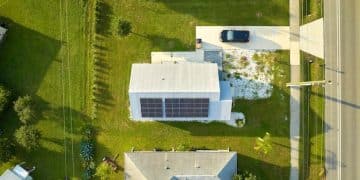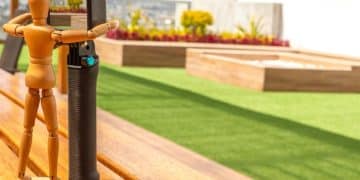Smart Irrigation Systems: Cut Water Use by 20% with Automated Sprinklers
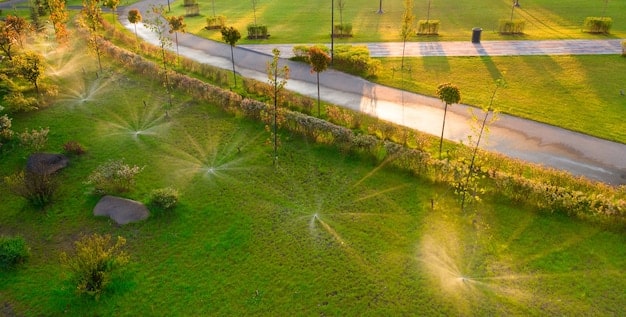
Anúncios
Smart irrigation systems leverage advanced technology to reduce outdoor water consumption by up to 20% through automated, data-driven scheduling, optimizing water delivery to landscapes and promoting environmental sustainability and cost savings for homeowners.
The pursuit of efficient resource management extends to every corner of our homes, including our gardens and lawns. In an era where sustainability is paramount, technologies are emerging to redefine how we interact with our environment. One such innovation, gaining significant traction, is the application of Smart Irrigation Systems: Reduce Water Consumption by 20% with Automated Sprinklers. These systems promise not only lush landscapes but also substantial savings on water bills, marking a pivotal shift towards smarter home technology.
The Evolution of Irrigation: From Hoses to Smart Automation
The way we water our gardens has undergone a remarkable transformation. For generations, garden hoses and manual sprinklers were the norm, relying heavily on guesswork and often leading to either overwatering or underwatering. This traditional approach, while seemingly simple, was inherently inefficient, contributing to significant water waste and potentially harming plant health. The challenge then was to introduce precision and intelligence into a historically rudimentary task.
Early Advances in Automated Sprinkler Systems
The first significant leap came with the introduction of automated sprinkler systems. These early versions offered a welcome departure from manual watering, allowing homeowners to set predefined schedules. However, while they brought convenience, they lacked adaptability. These systems would activate regardless of recent rainfall, soil moisture levels, or specific plant needs. They operated on a fixed timer, which, in many cases, meant watering a saturated lawn or during a downpour, undermining the goal of water conservation. This rigid programming highlighted the need for a more dynamic solution, one that could respond to real-time environmental conditions rather than operating blindly.
The Dawn of Smart Technology in Watering
The true revolution began with the integration of smart technology. This new generation of irrigation systems moved beyond simple timers, incorporating sensors, weather data, and artificial intelligence to make informed decisions. Suddenly, sprinklers could “know” when it rained, how much moisture the soil retained, and even the specific watering needs of different plant zones. This marked a paradigm shift from scheduled watering to intelligent, needs-based irrigation. The ability to automatically adjust to fluctuating conditions meant that water was applied only when and where it was truly needed, leading to unprecedented levels of efficiency. This adaptive capacity is what truly differentiates a smart system from its predecessors, moving past mere automation to true intelligence.
This evolution signifies more than just technological advancement; it represents a growing awareness and commitment to environmental stewardship. By optimizing water usage, smart irrigation systems not only conserve a precious resource but also contribute to a healthier ecosystem. The ability to dynamically manage water application reduces runoff, minimizes nutrient leaching, and ultimately fosters more resilient landscapes. Moreover, for homeowners, this translates into tangible benefits beyond just ecological responsibility. It means less time spent worrying about irrigation, lower water bills, and the peace of mind that comes with knowing their landscape is receiving optimal care with minimal waste. The journey from the humble garden hose to sophisticated smart automation is a testament to how innovation can profoundly impact our daily lives and our planet.
How Smart Irrigation Systems Work and Their Core Components
Understanding how smart irrigation systems achieve their remarkable efficiency involves delving into their operational mechanisms and the sophisticated components that make them function. These systems are not merely advanced timers; they are intelligent networks that collect data, analyze it, and make precise adjustments to watering schedules, ensuring every drop counts. Their effectiveness stems from a harmonious interplay of hardware and software, designed to mimic nature’s own intricate processes while optimizing for human-controlled environments.
Sensors: The “Eyes and Ears” of the System
At the heart of any smart irrigation system are its sensors. These devices are the primary data gatherers, providing real-time insights into environmental conditions.
- Soil Moisture Sensors: These are crucial. Buried beneath the soil, typically at root depth, they measure the volumetric water content. When the soil reaches a predefined moisture threshold, the system knows not to water, preventing over-saturation and conserving water. Conversely, when moisture levels drop below the optimal range, the system recognizes the need for irrigation.
- Rain Sensors: Installed in an exposed area, rain sensors detect precipitation. Upon sensing rain, they automatically pause or skip scheduled watering cycles, ensuring that sprinklers do not run during or immediately after a rainfall event. This eliminates wasteful watering of already wet landscapes.
- Flow Sensors: These sensors monitor the water flow through the irrigation pipes. They can detect leaks, broken pipes, or excessive flow rates, alerting homeowners to potential issues that could lead to significant water loss or damage.
These sensors transmit vital data continuously, forming the basis for the system’s intelligent decisions. Without accurate real-time data input from these sensors, the system’s ability to adapt would be severely limited, reducing its overall efficiency. They are the proactive elements that enable the system to react precisely to the immediate needs of the landscape.
Weather Data Integration: Predicting and Adapting
Beyond local sensors, smart irrigation systems heavily rely on integrating with external weather data. This is where predictive intelligence comes into play. Systems connect to local weather stations or online weather services to pull up-to-date forecasts.
When a system receives a forecast for significant rainfall in the next 24-48 hours, it can automatically delay or reduce scheduled watering, anticipating the incoming precipitation. Similarly, if a heatwave is predicted, the system might slightly increase watering duration or frequency to compensate for higher evaporation rates. This proactive adjustment based on forecasts significantly enhances water conservation and ensures plants receive adequate hydration even during rapidly changing weather patterns.
The ability of these systems to interpret and respond to both current and forecasted conditions is what sets them apart. It’s an intelligent response to environmental variables rather than a static, programmed approach. This integration of local sensor data with broader meteorological information creates a highly responsive and adaptive irrigation solution. It’s essentially the system calculating the precise amount of water needed, taking into account current humidity, wind speed, sunlight, and future weather anomolies. This dynamic adaptation not only saves water but also promotes healthier plant growth by avoiding the extremes of under or over-watering, which can stress landscapes.
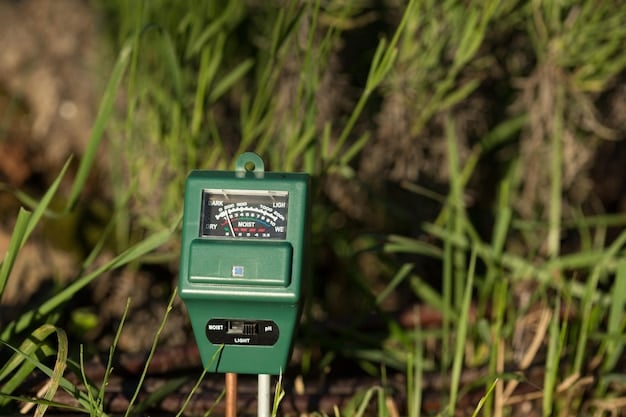
Central Controller and Software: The Brains Behind the Operation
The central controller is the brain of the smart irrigation system. This device, often accessible via a smartphone app or web portal, processes all the data from sensors and weather feeds. It then uses sophisticated algorithms to calculate optimal watering schedules for different zones within your landscape.
The software allows homeowners to:
- Set up different zones: Gardens often have different areas with varying needs (e.g., shady areas, sunny spots, different plant types). The controller allows for customized watering schedules for each zone.
- Access real-time data: Users can view sensor readings, historical watering data, and upcoming schedules.
- Adjust settings remotely: Whether on vacation or simply away from home, users can manage their irrigation system from anywhere.
This combination of components—sensors for precise data collection, weather integration for predictive capabilities, and a central controller with intuitive software for intelligent decision-making—culminates in a highly efficient and effective smart irrigation system. They represent a significant leap forward in home technology, offering not just convenience but tangible benefits in terms of water conservation and landscape health. The synergy between these elements ensures that water is delivered with unparalleled precision, minimizing waste and maximizing the vitality of your outdoor spaces.
Achieving a 20% Reduction: Quantifying Water Savings
The claim of reducing water consumption by up to 20% with smart irrigation systems is not merely a marketing promise; it’s a measurable outcome supported by numerous studies and real-world applications. This significant reduction stems from the intelligent optimization of water delivery, eliminating the inefficiencies inherent in traditional irrigation methods. Understanding how this reduction is achieved provides compelling evidence for the adoption of these advanced systems, both for environmental sustainability and economic benefits.
Eliminating Water Waste Through Precision Watering
The primary driver of water savings in smart irrigation is the elimination of unnecessary watering. Traditional systems often lead to significant waste due to:
- Overwatering: Applying more water than the soil can absorb or plants need. This leads to runoff, evaporation, and deep percolation beyond the root zone, all forms of waste. Smart systems prevent this by using soil moisture sensors and weather data to apply only the necessary amount.
- Watering during rainfall: Manually set timers or simple automatic systems continue to water even when it’s raining or has recently rained. Rain sensors in smart systems immediately shut down irrigation when precipitation is detected, conserving water that would otherwise be needlessly applied.
- Lack of zone-specific watering: Gardens are rarely uniform. Different areas may have varying soil types, sun exposure, or plant species, all with unique water requirements. Traditional systems apply a blanket watering schedule, leading to overwatering in some areas and under-watering in others. Smart systems allow for precise zone management, tailoring water delivery to specific needs.
By addressing these common pitfalls, smart irrigation systems ensure that water is used with remarkable precision, directly to the root zones where it’s needed most, and only when necessary. This targeted approach is fundamental to achieving substantial water savings, moving beyond generalized schedules to highly customized watering plans.
Case Studies and Real-World Examples of Savings
Numerous studies and installations across various regions have demonstrated the tangible water savings achieved by smart irrigation systems. For instance, a study conducted by the Alliance for Water Efficiency found that smart controllers could reduce outdoor water use by 15-30% compared to conventional timers. Individual homeowner testimonials often echo these findings, reporting noticeable drops in their water bills after switching to smart systems.
A community-wide initiative in a drought-prone region might install smart irrigation in parks and public spaces. They consistently report significant reductions in water usage, often exceeding initial projections, due to the system’s ability to adapt to variable weather conditions and soil moisture levels. These empirical observations solidify the theoretical potential of smart systems, transitioning them from a concept to a proven solution for water conservation. The consistent data collected from these real-world applications provides a strong argument for their widespread adoption, showcasing the system’s capacity to deliver on its promise of sustainable water management.
Calculating Your Potential Savings
To quantify potential savings, consider your current outdoor water consumption. If you use a significant portion of your water bill for irrigation, a 20% reduction can translate into substantial monetary savings over time. For example, if your average quarterly water bill is $150 and 60% of that ($90) is attributed to irrigation, a 20% reduction ($18) monthly can amount to over $200 per year. Over a decade, these savings can offset the initial investment in a smart irrigation system, making it a financially prudent choice in addition to its environmental benefits.
The investment in a smart irrigation system is not just about saving water; it’s about smart resource management, contributing to both a healthier landscape and healthier finances. The ability to precisely measure and then reduce consumption makes these systems a powerful tool in the arsenal of sustainable home technologies, providing clear, quantifiable benefits that impact both the planet and the homeowner’s wallet directly. The data consistently supports a strong case for their adoption, making them an increasingly essential component of modern, responsible home management.
Installation and Setup: A Step-by-Step Guide
Installing a smart irrigation system might seem like a daunting task, but with a clear understanding of the process, it becomes manageable for many homeowners. While professional installation for complex systems or large landscapes is often recommended, smaller setups can be a rewarding DIY project. The key is to approach it methodically, ensuring each component is properly integrated for optimal performance.
Planning Your Layout and Components
Before any physical installation, thorough planning is crucial.
- Assess your landscape: Identify different watering zones based on plant types, sun exposure, and soil conditions. This might include flower beds, vegetable gardens, shady lawns, or sunny areas. Each zone will have unique watering needs.
- Map your current system (if any): If you have an existing sprinkler system, understand its layout, pipe locations, and sprinkler head types. This information will guide the transition to a smart controller and sensor integration.
- Select components: Choose a smart controller compatible with your existing valves and choose appropriate sensors (soil moisture, rain, flow) based on your landscape size and specific needs. Consider system scalability if you plan to expand in the future. Researching product reviews and compatibility charts is advisable.
A well-thought-out plan at this stage minimizes potential issues during installation and ensures the system operates efficiently from day one. It serves as a blueprint, guiding every subsequent step. This initial assessment also helps in identifying any potential problem areas or zones that might require specific attention or specialized sprinkler heads to ensure uniform coverage.
Replacing Your Old Controller and Connecting Wires
This step is often the most straightforward for existing systems.
Start by safely disconnecting power to your old irrigation controller. Carefully label each wire connected to the old controller, noting its zone number or function (e.g., “Zone 1,” “Master Valve”). Once labeled, disconnect them. Mount the new smart controller in the same location or a suitable indoor/outdoor spot with power access. Connect the wires from your irrigation valves to the corresponding zone terminals on the new smart controller, following the specific wiring diagram provided by the manufacturer. The master valve wire and common wire (usually white) are critical for system operation. Ensure all connections are secure, as loose wires can cause system malfunctions. Once connected, restore power to the controller.
This is where the magic begins, as the new ‘brain’ of your system comes to life, ready to receive commands and data.

Integrating Sensors and Software Configuration
Once the controller is wired, it’s time to integrate the sensors and configure the software.
- Sensor Installation: Install rain sensors in an unobstructed location, typically on a gutter or fence, where they can accurately detect precipitation. Soil moisture sensors are typically buried in the root zone of representative areas within each irrigation zone. Flow sensors are installed inline with your main irrigation pipe. Follow manufacturer guidelines for optimal placement and calibration.
- Software Setup: Access the smart controller’s interface via its dedicated app or web portal. This is where you’ll define your irrigation zones, assign sensor inputs, and configure watering schedules. Input details such as soil type, plant type, sun exposure, and sprinkler head type for each zone. These parameters allow the system’s algorithms to calculate optimal watering times. Perform system tests to ensure all zones activate correctly and sensors are communicating properly.
This phase is where your smart irrigation system truly becomes “smart.” Careful and accurate configuration of the software is essential for maximizing water savings and maintaining a healthy landscape. Take your time to fine-tune the settings, as even small adjustments can impact overall system efficiency. A well-configured system acts like a personalized watering expert, adapting to your garden’s specific needs and the whims of local weather patterns. Regular monitoring of the system’s performance and periodic adjustments, especially during seasonal changes, will ensure continued efficiency and optimal landscape health.
Benefits Beyond Water Savings: Ecology and Economy
While the direct reduction in water consumption is a compelling reason to adopt smart irrigation systems, their benefits extend far beyond merely conserving a precious resource. These systems contribute to a broader ecological harmony and offer significant economic advantages, making them a wise investment for homeowners prioritizing sustainability and long-term value.
Ecological Impact: Healthier Landscapes and Reduced Runoff
The precision watering offered by smart irrigation systems has a profound positive impact on the environment.
- Healthier Plant Growth: By delivering the right amount of water at the right time, smart systems reduce the risk of over or under-watering, both of which can stress plants. This leads to more robust, resilient, and visually appealing landscapes. Healthy plants are better able to withstand pests and diseases, requiring fewer chemical interventions.
- Reduced Nutrient Leaching: Overwatering can wash away essential nutrients from the soil, carrying them away as runoff. This not only deprives plants of vital sustenance but also contributes to nutrient pollution in local waterways, potentially leading to algae blooms and ecosystem damage. Smart irrigation minimizes runoff, keeping nutrients where they belong – in the soil.
- Soil Health Preservation: Consistent overwatering can compact soil, reduce aeration, and inhibit beneficial microbial activity. Precision irrigation helps maintain optimal soil moisture levels, fostering a healthier soil structure and promoting the flourishing of beneficial microorganisms, which are vital for plant health.
These systems play a crucial role in creating a balanced garden ecosystem. They promote efficient absorption of water by plants, decrease strain on local water treatment facilities, and reduce the carbon footprint associated with water pumping and purification. The ripple effect of such ecological responsibility contributes to a greener urban environment and supports biodiversity by creating healthier habitats for local flora and fauna.
Economic Advantages: Lower Bills and Property Value
The financial benefits of smart irrigation systems are immediately apparent and continue to accrue over time.
The most direct saving comes from reduced water bills. Given that outdoor irrigation can account for a significant portion of residential water use, a 15-30% reduction directly translates into tangible savings each billing cycle. Over the lifespan of the system, these savings can easily outweigh the initial investment, making it a financially sound decision. Furthermore, many utility companies and local governments offer rebates or incentives for installing water-efficient technologies, further reducing the upfront cost.
Beyond immediate savings, a well-maintained and lush landscape enhances property curb appeal and value. A smart irrigation system ensures your landscape remains vibrant and healthy year-round, which can be a significant selling point if you ever decide to move. Homebuyers are increasingly looking for properties with sustainable features and lower operational costs, making smart irrigation an attractive amenity.
Moreover, by preventing overwatering and potential water damage to foundations or other structures from excessive runoff, these systems can also save homeowners from costly repairs in the long run. The combination of direct cost savings, increased property value, and eligibility for incentives positions smart irrigation as a smart economic choice for the modern homeowner. It represents a long-term investment that yields both environmental goodwill and financial returns, striking a perfect balance between ecological responsibility and economic foresight.
Maintaining and Optimizing Your Smart Irrigation System
Installing a smart irrigation system is just the first step; ongoing maintenance and optimization are crucial to ensure its long-term efficiency and continue to reap its benefits. These systems, while largely automated, still require periodic attention to perform optimally and prevent potential issues. A proactive approach to care ensures that your investment continues to deliver maximum water savings and maintain a vibrant landscape.
Seasonal Adjustments and Routine Checks
Even with intelligent automation, seasonal changes require a degree of oversight and adjustment.
- Spring Startup: As temperatures rise and the landscape wakes from dormancy, it’s essential to perform a thorough system check. Inspect all sprinkler heads for damage, blockages, or misalignments. Run each zone manually to check for proper coverage and pressure. Confirm that the rain sensor is clean and functioning correctly. Some systems may require recalibration of soil moisture sensors after winter.
- Summer Monitoring: During peak growing season, regularly monitor your landscape for signs of stress or overwatering. While the system adjusts automatically, extreme heatwaves or unusual dry spells might require minor manual overrides or fine-tuning of zone settings. Keep an eye on your water bill for unexpected spikes, which could indicate a leak or system malfunction.
- Fall Shutdown: As cooler weather approaches, gradually reduce watering frequency. In regions where temperatures drop below freezing, proper winterization is critical. This involves shutting off the main water supply to the irrigation system and blowing out the lines with compressed air to prevent freezing and pipe damage.
Regular visual inspections of your landscape, combined with occasional checks of the system’s performance metrics through its app, will help you identify and address any issues promptly. This proactive maintenance ensures the system consistently meets your landscape’s evolving needs throughout the year, preventing both water waste and plant health problems.
Troubleshooting Common Issues and Software Updates
Despite their sophistication, smart irrigation systems can encounter common issues.
One frequent problem is sensor malfunction. If your system seems to be watering excessively or not enough, check the calibration and cleanliness of your soil moisture and rain sensors. Debris can block rain sensors, or soil shifting can affect moisture readings. Connectivity issues, especially with Wi-Fi-enabled controllers, can also arise. Ensure your home network is stable and the controller has a strong signal. If a zone isn’t watering, check the wiring at both the controller and the valve, and inspect the valve itself for any blockages or wear.
Software and firmware updates are also vital. Manufacturers frequently release updates to improve performance, add new features, fix bugs, and enhance compatibility. Ensure your controller’s software is always up to date, as these updates can significantly impact the system’s efficiency and reliability. Most modern smart controllers can receive over-the-air updates, making the process relatively easy. Regularly checking for and installing these updates can proactively prevent issues and ensure your system continues to utilize the latest advancements in irrigation technology.
By staying informed and actively engaging with your smart irrigation system, you can maximize its lifespan, optimize its performance, and continue to enjoy the significant ecological and economic benefits it provides, solidifying its role as a cornerstone of modern home technology. This ongoing attention transforms an initial investment into a sustained advantage, ensuring your landscape thrives with minimal resource consumption.
Choosing the Right Smart Irrigation System for Your Home
Selecting the ideal smart irrigation system requires careful consideration of various factors, including your landscape’s unique characteristics, budget, existing infrastructure, and desired level of control. The market offers a diverse range of options, from basic Wi-Fi controllers to sophisticated, sensor-driven networks, each designed to meet different needs. Making an informed decision ensures you invest in a system that delivers maximum efficiency and value.
Assessing Your Landscape and Needs
The first step is to thoroughly evaluate your outdoor space.
- Size and Complexity: Do you have a small backyard with uniform lawn, or a large property with multiple zones, diverse plant types, and varying sun exposure? Larger, more complex landscapes will benefit from systems that support more zones and advanced sensor integration.
- Plant Types: Different plants have different watering requirements. Drought-tolerant native plants will need less water than a lush vegetable garden. Choose a system that allows for customized scheduling per zone based on specific plant needs.
- Soil Type: Sandy soils drain quickly and require more frequent, shorter watering cycles, while clay soils retain water longer and need less frequent, deeper watering. Some advanced systems allow you to input soil type for more accurate calculations.
Understanding these variables will help you narrow down the type and features of the smart irrigation system best suited for your home. It’s about tailoring the technology to your existing environment, ensuring an efficient and harmonious integration from the outset, leading to optimal plant health and water conservation.
Key Features to Look For: From Basic to Advanced
Smart irrigation systems come with a range of features, and distinguishing between essential and desirable ones can guide your choice.
- Weather Intelligence: This is a fundamental feature. Ensure the system can connect to local weather data to adjust schedules based on real-time and forecasted rain, temperature, and humidity.
- Zone Control: The more independent zones a controller can manage, the more customizable your watering schedules can be. This is crucial for diverse landscapes.
- Sensor Compatibility: Consider if the system is compatible with soil moisture, rain, and flow sensors. While some systems come with built-in or proprietary sensors, others are open to third-party integrations, offering more flexibility.
- Remote Access and App Interface: A user-friendly mobile app or web interface is essential for convenient remote management, scheduling adjustments, and monitoring system performance. Check for intuitive design and robust functionality.
- Smart Home Integration: If you have other smart home devices (e.g., Google Home, Amazon Alexa), consider systems that can integrate with these platforms for voice control or unified automation.
- Water Flow Monitoring: Advanced systems can monitor water flow rates, alerting you to potential leaks or pipe issues, which can save you from significant water damage and waste.
Prioritizing these features based on your needs will ensure you select a system that not only conserves water but also provides the level of convenience and control you desire. A system that offers robust weather adaptation and comprehensive zone control will likely provide the best long-term return on investment, aligning both economic and ecological objectives for homeowners.
Budget and Professional Installation Considerations
The cost of smart irrigation systems varies widely depending on features, brand, and complexity. Entry-level Wi-Fi controllers might be a few hundred dollars, while comprehensive systems with multiple sensors and professional installation can run into several thousands.
Consider your budget and the potential long-term water bill savings. While the upfront cost might seem higher than a basic timer, the return on investment through water conservation can make it a financially sound decision. For complex installations, or if you’re not comfortable with electrical wiring and plumbing components, professional installation is highly recommended. A certified irrigation specialist can ensure the system is properly sized, installed, and configured for optimal performance, preventing costly mistakes and maximizing efficiency. They can also offer expert advice on zone layout and specific watering needs for your landscape, providing a holistic solution that goes beyond just hardware installation. Ultimately, choosing the right smart irrigation system is about balancing functionality, budget, and ease of installation to achieve a water-efficient and beautiful landscape.
| Key Point | Brief Description |
|---|---|
| 💧 Water Savings | Reduces outdoor water consumption by 15-30% by eliminating waste and optimizing schedules based on real-time data. |
| 🌱 Landscape Health | Ensures optimal hydration for plants, leading to healthier growth, reduced stress, and increased resilience against pests. |
| 💰 Economic Benefits | Lowers water bills significantly and can increase property value, with potential rebates available from utility providers. |
| 🛠️ Smart Features | Utilizes sensors (soil moisture, rain, flow) and weather data for adaptive scheduling, offering remote control via apps. |
Frequently Asked Questions About Smart Irrigation Systems
Studies and real-world data consistently show that smart irrigation systems can reduce outdoor water consumption by 15% to 30%. This significant saving is achieved by eliminating overwatering, skipping cycles during rain, and tailoring water delivery precisely to specific landscape needs, preventing needless waste and optimizing resource use for efficiency.
For replacing an existing controller, installation can be a straightforward DIY project for many homeowners. However, for complex landscapes, new installations, or if you’re not comfortable with wiring and plumbing, professional installation is recommended. Most systems prioritize user-friendly setup with clear instructions and app-guided configuration ensuring a smooth transition.
While largely automated, smart irrigation systems benefit from routine checks and seasonal adjustments. This includes inspecting sprinkler heads, cleaning sensors, and performing system winterization in colder climates. Regular software updates are also crucial to ensure optimal performance and access to the latest features and bug fixes from manufacturers.
Traditional irrigation relies on fixed, pre-set timers regardless of actual landscape needs or weather conditions. Smart irrigation, in contrast, uses real-time data from sensors (soil moisture, rain, flow) and weather forecasts to dynamically adjust watering schedules, ensuring water is applied only when and where it’s truly needed, maximizing efficiency and minimizing waste.
Many smart irrigation systems offer integration with popular smart home platforms like Amazon Alexa, Google Home, and Apple HomeKit. This allows for voice control, unified management through a central app, and enhanced automation scenarios, bringing your outdoor watering into the broader ecosystem of your connected home for seamless operation and convenience.
Conclusion
The journey towards sustainable living often involves embracing technological advancements that make resource management more efficient and less burdensome. Smart irrigation systems: reduce water consumption by 20% with automated sprinklers stand as a testament to this principle, offering a sophisticated yet accessible solution for homeowners seeking to optimize their outdoor water use. By leveraging sensors, weather data, and intelligent algorithms, these systems transcend the limitations of traditional watering methods, delivering water with unprecedented precision and eliminating wasteful practices. The benefits extend far beyond mere water conservation; they contribute to healthier, more resilient landscapes, reduce utility bills, and enhance property value, all while contributing to a more ecologically responsible lifestyle. As we look to the future, the integration of such smart technologies into our homes becomes not just an option, but an imperative for fostering a sustainable relationship with our environment.
